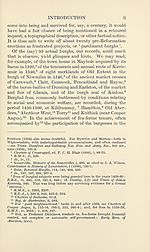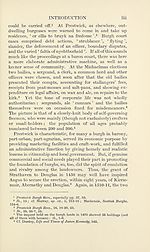Series 3 > Court book of the Burgh of Kirkintilloch 1658-1694
(59) Page lii
Download files
Complete book:
Individual page:
Thumbnail gallery: Grid view | List view

lii KIRKINTILLOCH BURGH COURT BOOK
election of bailies and councillors, the pioneer, Dunferm¬
line,1 was followed not only by the great Church burghs of
Kirkcaldy (1451),2 Musselburgh (1466),3 and Paisley (1490)4
but also by the lesser (and secular) burghs of Kirkintilloch
(1520),5 Kilmaurs (1527) 6 and Hawick (1537).7
In most of these burghs, whatever the tenure, land-rights
—due cultivation, privilege of pasture, ‘ commonty ’—
formed the broad base of the economy, while trade and
crafts supplied merely the superstructure. Thus the men
of Keithick must ‘ keip gud nychtburhed and thair land
fra guld \8 the 40 burgesses of Kilmaurs were essentially
small-holders, though obliged to dwell in the little urban
centre, to which, also, the crafts and the merchandise of
the whole barony were ‘ banned ’,9 and the 74 tenements
of Hawick, on the north and south sides of the public street,
were allocated to the burgesses along with a share of
common pasturage.
The best documented—as well as the most clearly
typical—of the baronial burghs is Prestwick, with records
extant from 1470. Here the bailies, with the consent of
the community, made regulations about the upholding of
dykes, the restraining of swine and geese, the sowing of
pease. Any undue cutting of peat or turf, pulling of bent,
of shearing of grass was forbidden, as was the keeping of
‘ scabyt horse ’ or the gathering of more sea-wrack than
1 In 1395 : supra, p. xxxv.
2 Reg. de Dunfermelyn, 318-19 ; but a copy of the indenture in Register
House, Douglas Bequest (for a transcript of which I am indebted to
Dr. A. I. Dunlop), bears date 20 Oct. 1450.
3 Reg. de Dunfermelyn, 357-8.
4 Reg. de Passelet, 264-8 ; the burgesses paid multuram ad tricesimum
vas at the abbot’s mill—a preferential rate, as other tenants paid vicesimum
primum vas : R.M.S., v, 1297.
6 Note in Wigtown Charter Chest, no. 883 ; cf. Munic. Carp. Comm.
Local Reports, ii, 109 (where the date is 10 Dec. 1525).
6 lb., 104 ; McNaught, Kilmaurs Parish and Burgh, 336-40.
7 Munic. Corp. Comm. Local Reports, ii, 81-2 ; R.M.S., iii, 3107.
8 Again, land must be put to all possible ‘ pollecy and gudding ’.
(‘ Guld ’ = corn-marigold, a great enemy of farm crops.)
9 Cf. McNaught, op. cit., 223-5 ; Murray, Early Burgh Organisation,
ii, 296.
election of bailies and councillors, the pioneer, Dunferm¬
line,1 was followed not only by the great Church burghs of
Kirkcaldy (1451),2 Musselburgh (1466),3 and Paisley (1490)4
but also by the lesser (and secular) burghs of Kirkintilloch
(1520),5 Kilmaurs (1527) 6 and Hawick (1537).7
In most of these burghs, whatever the tenure, land-rights
—due cultivation, privilege of pasture, ‘ commonty ’—
formed the broad base of the economy, while trade and
crafts supplied merely the superstructure. Thus the men
of Keithick must ‘ keip gud nychtburhed and thair land
fra guld \8 the 40 burgesses of Kilmaurs were essentially
small-holders, though obliged to dwell in the little urban
centre, to which, also, the crafts and the merchandise of
the whole barony were ‘ banned ’,9 and the 74 tenements
of Hawick, on the north and south sides of the public street,
were allocated to the burgesses along with a share of
common pasturage.
The best documented—as well as the most clearly
typical—of the baronial burghs is Prestwick, with records
extant from 1470. Here the bailies, with the consent of
the community, made regulations about the upholding of
dykes, the restraining of swine and geese, the sowing of
pease. Any undue cutting of peat or turf, pulling of bent,
of shearing of grass was forbidden, as was the keeping of
‘ scabyt horse ’ or the gathering of more sea-wrack than
1 In 1395 : supra, p. xxxv.
2 Reg. de Dunfermelyn, 318-19 ; but a copy of the indenture in Register
House, Douglas Bequest (for a transcript of which I am indebted to
Dr. A. I. Dunlop), bears date 20 Oct. 1450.
3 Reg. de Dunfermelyn, 357-8.
4 Reg. de Passelet, 264-8 ; the burgesses paid multuram ad tricesimum
vas at the abbot’s mill—a preferential rate, as other tenants paid vicesimum
primum vas : R.M.S., v, 1297.
6 Note in Wigtown Charter Chest, no. 883 ; cf. Munic. Carp. Comm.
Local Reports, ii, 109 (where the date is 10 Dec. 1525).
6 lb., 104 ; McNaught, Kilmaurs Parish and Burgh, 336-40.
7 Munic. Corp. Comm. Local Reports, ii, 81-2 ; R.M.S., iii, 3107.
8 Again, land must be put to all possible ‘ pollecy and gudding ’.
(‘ Guld ’ = corn-marigold, a great enemy of farm crops.)
9 Cf. McNaught, op. cit., 223-5 ; Murray, Early Burgh Organisation,
ii, 296.
Set display mode to:
![]() Universal Viewer |
Universal Viewer | ![]() Mirador |
Large image | Transcription
Mirador |
Large image | Transcription
Images and transcriptions on this page, including medium image downloads, may be used under the Creative Commons Attribution 4.0 International Licence unless otherwise stated. ![]()
| Scottish History Society volumes > Series 3 > Court book of the Burgh of Kirkintilloch 1658-1694 > (59) Page lii |
|---|
| Permanent URL | https://digital.nls.uk/126713871 |
|---|
| Attribution and copyright: |
|
|---|
| Description | Over 180 volumes, published by the Scottish History Society, containing original sources on Scotland's history and people. With a wide range of subjects, the books collectively cover all periods from the 12th to 20th centuries, and reflect changing trends in Scottish history. Sources are accompanied by scholarly interpretation, references and bibliographies. Volumes are usually published annually, and more digitised volumes will be added as they become available. |
|---|


